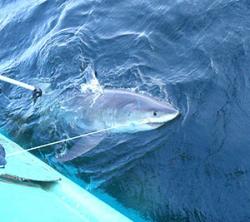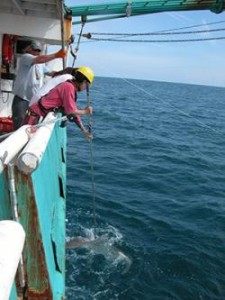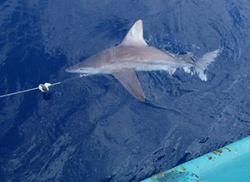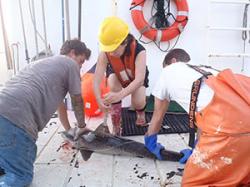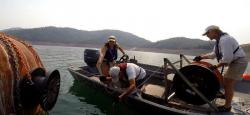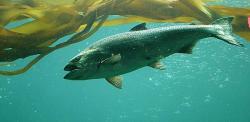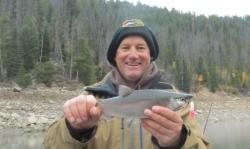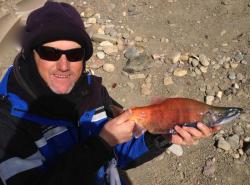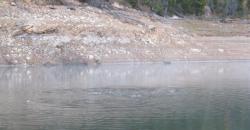Bass fishermen have something to look forward at the beginning of September each year. It will only be about another month before fishing gets good again after a long hot summer. September can be a mean month for catching bass, but they can be caught even now. Yes, you can catch bass in Georgia in September
Our Georgia lakes are as hot as they get all year in September and oxygen content is at its lowest level. And there are more baitfish making easy meals for bass, but shad and herring draw them to open water, making them harder to find and pattern.
Fortunately, there are three patterns that will usually pay off in September. You may be able to find bass on all three on some lakes but at least one or two will work on all our lakes. You can fish at night, go deep or find moving water.
At night many bass move shallow and get more active. For years fishing early in the morning and late in the afternoon has been known as the best time to catch bass in hot weather. Extend that and fish during the dark. It means adjusting some of the things you do, and works best on clear lakes, but you will be more comfortable and catch more bass after the sun goes down.
Fishing deep it a traditional way to catch bass in hot water and bass are schooled up and holding on deep structure and cover. It takes special techniques to find and catch them, but once you find a school you can often catch large numbers of fish in one spot. And bass often come up from deep cover to hit baitfish on top, opening up an exciting way to catch them.
Current turns bass on and finding moving water usually means catching bass. Everything from natural current way up rivers and creeks to water moving across main lake points from power generation at the dam will make bass feed. Look in the right places and you can find active bass in current in most of our lakes.
Each of the following lakes has its own characteristics that fit some of the above three methods of catching September bass:
Thurmond (Clarks Hill}
One Labor Day weekend several years ago I was staying at my place at Raysville Boat Club on Clark’s Hill and woke up very early Saturday morning. I was too excited about an afternoon dove shoot to sleep, so I got in the boat and idled across to a brush pile I had built in eight feet of water. The full moon was beautiful and lit the lake brightly enough to throw shadows.
A bass took my Texas rigged curly tail worm in the brush and jumped twice when I set the hook. It looked to be well over eight pounds, but it threw the hook on the second jump. Two weeks later, just before the sun rose over the trees, I hooked and landed my first nine-pound bass from that same brush pile, on the same kind of worm.
Fishing at night is very good at Clarks Hill and you can catch bass from sunset until sunrise in shallow water. There is a full moon on September 23 this year and there is no more exciting way to catch bass than running a buzzbait or Jitterbug over shallow cover in the moonlight. Fish a topwater bait slowly and steadily to give the bass a better shot at it.
Riprap is always good on Clarks Hill at night but shallow hydrilla beds are excellent, too. Start fishing as the sun sets and keep fishing topwater as long as there is any light, working around the outside edges of the hydrilla and through cuts in it. It is best to locate the beds in daylight so you have an idea of the area to fish. Keep at it until the sun rises.
On dark nights work a Texas rigged worm on a light lead or a light jig and pig around riprap and the hydrilla, too. Crawl both baits on the rocks and drop them into holes and cuts in the hydrilla. You can use a black light to help you see the cover and your line, but this is a great way to learn to feel what your bait is doing.
Moving water is hard to find on Clarks Hill but you can run up the Savannah River to near the Russell dam and catch current flowing both ways. When power is being generated at the Russell dam strong current flows down the river. At night and early in the morning when the Corps is pumping water back into Russell current goes up the river.
Get out on main lake points and work a big crankbait or big Carolina rigged worm with the current. The bass will usually hold on the break on the downstream side of the current, so their position will change depending on which way the water is flowing.
On most of the lake, current is not a factor and bass hold as deep as oxygen levels allow. One year in late August I was playing with an oxygen monitor and discovered there was not enough oxygen below 11 feet deep in the Raysville area for a bass to survive. Further down the lake the depth of good oxygen got deeper.
Ride over deep points and humps watching your depthfinder. When you find fish, often holding near stumps and brush on the steepest drop on the structure, back off and make long casts with a big crankbait or big Carolina or Texas rigged worm. Bass will usually be holding from 18 to 30 feet deep on the lower Savannah River and Little River areas of the main lake.
Watch for surface activity in these same areas. Largemouth will come up to the surface to hit blueback herring and shad and will fall for topwater plugs like Spooks and Sammys. Work these baits over the deep cover even if they are not coming up and you can sometimes draw them to the surface.
Lanier
Lanier means spots and herring in September, and night fishing is usually best on this big, heavily used lake. At night you can actually hold your boat on points on the main lake without getting thrown out by the wake of passing cruisers. And it is a lot cooler.
Lanier is so clear and busy with pleasure craft that bass usually hold deep even at night. You can fish the same places and patterns day and night to catch them, and use the same baits.
Laura and Trent Gober fish many tournaments on Lanier and often finish high on the list. Laura fished the Women’s Bass Tour before it closed and did well on that trail, too. Lanier is her home lake and she loves to go after the big spots there.
Find brush on a deep hump or point and you are likely to find big spots holding there day and night. And think real deep. Bass on Lanier often hold 30 to 60 feet deep. It is harder to fish that deep but it pays off in bigger fish.
Laura likes to throw a Texas rigged Senko on light line and work it through the brush and any other cover on points and humps from Brown’s Bridge to the dam. Ride over the humps and points watching your depthfinder carefully for cover. Sometimes you will see the fish in it if you have a good unit. When you spot a likely looking place, throw a marker out a few feet from it so you can stay on it. At night you can attach a small glow stick to your marker so you can see it.
Back off and make long casts. Feed line out so your lure sinks straight down. When fishing extreme depths, if you don’t let your lure sink on a slack line, the lure will swing way off the cover as it sinks. When you hit the cover, work your bait in it slowly, twitching it in one spot. Yo-yo it on limbs in brush piles, making it dance up and down in one spot.
The same deep places hold bass day and night and the Texas rigged worm works well, but blueback herring offer another option during the day. Bass holding 30 feet deep in brush and tree tops will come to the surface to eat herring that swim near the top on bright, sunny days. During the day, find deep cover, back off and cast a topwater bait like a Spook or Sammy over it. A Fluke can be worked in the same spots in the same way.
Make long casts and work the bait fast, making it look like a bass chasing a herring across the surface. Be ready for a smashing hit when a big spots comes rushing up for an easy meal.
Finding current on Lanier means running way up the Chattahoochee River, and you need a shallow draft boat to be safe. You have to be very careful in any boat, but if you go up the river far enough you will find moving water. If power is being generated at the dam you can find current further down the river.
When you get to moving water fish any cover you see with a Texas rigged worm. Most cover this far up the river will be shoreline rocks and trees in the water. Pitch your bait to the upstream side of the cover and let is wash downstream with the current in a natural movement.
You can also keep your boat downstream of the cover and cast a small crankbait up past it and work it back. Make it look like a baitfish being moved down the river, making it an easy meal for waiting bass.
Oconee
Lake Oconee is unusual for its strong currents that flow both ways. Power generation at the dam creates current all over the lake, and the pumpback moves water back upstream far up the Oconee River and main creeks. That current makes the bass feed heavily in September.
Terry Adams lives near Oconee and fishes it often. He won the BFL and an Oconee Marine tournament on Oconee two years ago with five bass limits weighing over 17 pounds in each. In 2006 he and one of his mentors, Jack Brown, won the Berry’s Classic on Oconee and Sinclair. Terry has won several other tournaments there including some of the old JR Tournaments.
Docks are a key to Terry’s fishing and he looks for docks on deep water. He wants to find a dock with at least ten feet of water in front of it. He pitches a jig and pig to the dock posts, lets it sink to the bottom, strokes it up off the bottom and lets it fall back, then hits the next post. He does not try to get his bait way back under a dock, he says too many fish get tangled up and break off. He looks for active fish on the outside posts.
Current running by the docks makes them much better and pulls the fish out to the outside posts. Waves from passing boats can do this, too, so Terry likes boat traffic. Docks from the Highway 44 Bridge to the mouth of Richland Creek are his favorite ones.
Docks are good at night, too. Terry will look for a lighted dock and run a crankbait under the light if he can get an angle on it. He casts a Shadrap or other small crankbait in shad color. He will also pitch a big worm to the lights. Dock lights are inconsistent on Oconee because they get turned on and off. The best bet is to ride the lake and hit any lighted docks you find.
Fishing a big crankbait 12 to 20 feet deep on points and humps is a good way to catch quality bass on Oconee, too. The bass will hold on the drop on the downstream side of the current, so that can change between generation current running downstream and pumpback current running upstream. Find the drop with your depthfinder then make long casts to get your bait down to the bottom.
West Point
Although the Corps of Engineers seems determined to remove as much shoreline cover as they can pile up and burn every winter, night fishing around blowdowns and stumps can be good at West Point. Brushpiles are also good in the dark and any wood cover you can find will produce bass in the dark.
Find blowdowns during daylight hours and learn how they lay and how to fish them when you can see them. Also find deeper brush on points and humps and mark it. Work a Texas rigged worm through all the wood cover. A big worm, from a Zoom Mag 2 up to an Old Monster, in dark colors, will draw bites from fish holding in the wood.
Look for blowdowns from Highland Marina up Yellowjacket Creek and the Chattahoochee River. From Highland Marina down, much of the shoreline cover has been removed so look for brush piles in 10 to 20 feet of water to fish. If you ride almost any point or hump you will find bush somebody has put out.
During the day bass really key on current moving across the humps and points on the main lake. Week days are best by far since power generation is stronger and more consistent than on weekends. Current moves schools of shad across deeper cover and bass feed heavily on them.
Look for roadbeds, humps and long points from Highland Marina to the dam. Bass will often feed during the day from 12 to 30 feet deep as current flows across them, and they will usually hold on the downsteam side, where there is a drop. Cover like brush and stumps make it even better.
Big crankbaits like Mann’s 20+, Fat Free Shad and Norman DD22 Ns work well to imitate the shad the bass feed on and get down deep enough to catch them. You need to fish them on eight to 10 pound line to get them deep, and fluorocarbon line is best since it is thin, sinks and does not stretch much.
Get on the downstream side of structure and cover and make long casts upstream. Stay close enough to the cover to get your bait down to it. It takes 20 to 30 feet to get a big crankbait down 20 feet, so you have to cast that far past the target to hit it.
Reel your lure steadily with a medium speed. When you hit cover, pause it a second and let it float up, then jerk it so it darts away. Check your line on every cast since it will get frayed hitting the cover.
You can catch bass right now. Try these tactics and adapt them to the ways you fish, and you won’t have to wait another month to enjoy successful bass fishing!
